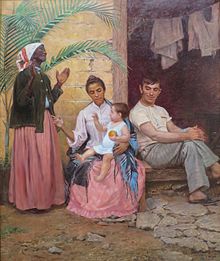
Blanqueamiento in Spanish, or branqueamento in Portuguese (both meaning whitening), is a social, political, and economic practice used in many post-colonial countries in the Americas and Oceania to "improve the race" (mejorar la raza)[1] towards a supposed ideal of whiteness.[2] The term blanqueamiento is rooted in Latin America and is used more or less synonymously with racial whitening. However, blanqueamiento can be considered in both the symbolic and biological sense.[3] Symbolically, blanqueamiento represents an ideology that emerged from legacies of European colonialism, described by Anibal Quijano's theory of coloniality of power, which caters to white dominance in social hierarchies.[4] Biologically, blanqueamiento is the process of whitening by marrying a lighter-skinned individual to produce lighter-skinned offspring.[4]
- ^ Rahier, J.M. (1999). "Body politics in black and white: Senoras, Mujeres, Blanqueamiento and Miss Esmeraldes 1997-1998, Ecuador". Ecuador, Women & Performance: A Journal of Feminist Theory. 11 (1): 103–120. doi:10.1080/07407709908571317.
- ^ Hernandez, Tanya Kateri (2001). "Multiracial Matrix: The Role of Race Ideology in the Enforcement of Antidiscrimination Laws, a United States-Latin America Comparison". Cornell Law Review. 87: 1093–1176.
- ^ Sawyer, M.Q. & T.S. Paschel (2007). ""We didn't cross the color line, the color line crossed us"—Blackness and Immigration in the Dominican Republic, Puerto Rico, and the United States". Du Bois Review. 4 (2): 303–315. doi:10.1017/S1742058X07070178. S2CID 7725596.
- ^ a b Montalvo, F. F. & G. E. Codina (2001). "Skin Color and Latinos in the United States" (PDF). Ethnicities. 1 (3): 321–41. doi:10.1177/146879680100100303. S2CID 145400906.
